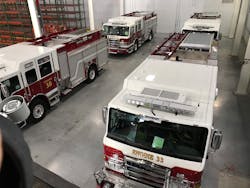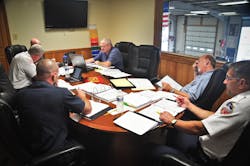When the budget has been approved to purchase and build an apparatus, it is time for the apparatus purchasing committee (APC) to meet. The APC is dynamic in nature, which means that it may include driver/operators, officers, paramedics (if the specification will be ALS capable), chief officers, an internal purchasing representative, an IT representative, and an emergency vehicle technician (EVT). An ideal APC has no more than eight and no fewer than three individuals.
The committee is a dedicated group that analyzes changes in the department, manufacturing processes, technological innovations, and apparatus and equipment safety, while remembering their fiduciary responsibilities. The apparatus committee chair is the authority having jurisdiction (AHJ) and sets the direction and goals for the committee throughout the process.
Staying focused
Part of the process is the rumor control. Some committee members may share a snippet of the process and suddenly the chief’s vehicle transforms into a heavy rescue and three tillers! Nonetheless, now is the time for the AHJ to step in and meet with the committee members, managing rumor control in the department, while staying focused on the direction of the current process.
Also, there may be an emotional component to the APC. For example, let’s say the APC has created an emergency warning lighting specification for the new apparatus that requires a “well-lighted and safe custom apparatus with enough emergency lighting to protect the crews while blocking on the highway.” During the mid-build visit, differing opinions arise among the APC members based on personal preference, experience, tenure, position, etc. This is when the AHJ must remind the committee of the original lighting specification they helped draft. Even though discussion about the lighting package is healthy, they must stay the course with the initial specifications. Committee members won’t always agree, and pet peeves and stubbornness can stall the process, which is when the AHJ must consider the concept of needs vs. wants.
Most departments have APCs that work very well together and fulfill their duty admirably. Other departments may not have this luxury, and will need to hire a consultant. Committee members often come to the table with their lists of personal whims, wishes and desires that may become controversial in the process. As such, a conscientious AHJ is responsible for developing a charter that will keep members in check. Once a charter is developed and deployed, the AHJ has guidelines to monitor and direct all personalities and establish committee-level priorities. That in itself may be more challenging than agreeing on a make and model and apparatus color.
As work progresses, internal committee priorities may need modification and restructuring. That’s where the needs vs. wants factors in.
Operational approach
In an effort to provide cost-effective emergency services on a limited budget, fire departments look for ways to incorporate operational efficiency into the specifications that mold the designs of new apparatus purchases. In other words, apparatus and equipment are designed for operational functionality, not just good “curb appeal.”
For many years, departments used a detailed specification that could be upward of 2,000 pages with an index, specifications and appendices that covered every facet of the apparatus, including the type and size of filters, wiring color and gauge, bolts, valves, differential ratio, diamond plate grade, door hinges, hosebed vinyl texture and thickness, and more.
A more lean and economical approach is now geared to providing the dealers and manufacturers a more functional specification that is an operational specification that provides information about the jurisdiction’s geographical location, including the square miles and the population covered. Using this specification style also provides the criteria about the departmental personnel, ISO rating, community types (rural/suburban/inner-city), cab size, engine and drive train needs, equipment, hose, water tank size, pump size, etc. These are critical items that need to be reviewed by a diverse APC.
Gauging success
The apparatus committee will critically assess all specifications, inspections, testing and documentation for all the departmental emergency apparatus. One way to ascertain apparatus committee success indicators is to repeatedly reflect on the charter that focuses on the full lifecycle of the apparatus.
Some success indicators include:
· Cost effectiveness and operational value
· Ability of department personnel to efficiently operate on a day-to-day basis
· Ability of standardized purchases to create lower costs related to the initial purchase as well as ongoing maintenance and repair
· An efficient purchasing, replacement and maintenance program for all apparatus
· Decisions bound by budgetary constraints in addition to aligning with the long-term goals of strategic and capitol replacement programs
· Determination that the design and function of the emergency fleet provides adequate safety
Another important issue to consider is the economic variables in a replacement analysis. Economic data from replacement analysis is frequently overlooked, possibly because it is extremely difficult for fire departments to extrapolate, or they simply don’t think about this data. But this data is imperative to use in projecting inflation, depreciation, discount rates and the importance of variable costs such as repair and maintenance, downtime, and the number of calls in the district to which the unit will be assigned.
Economic indicators are critical components of replacement analysis because they serve to adjust apparatus cost through time. These indicators have a considerable impact on both apparatus capital and operating budgets. The economic life of a unit refers to the length of time over which the average total apparatus cost is the lowest.
Total apparatus costs associated with ownership of equipment include:
· Depreciation
· Operation and maintenance
· Downtime versus availability
· Obsolescence
· Operator training time and costs
· Parts inventory via factory or dealer
· Value of money (i.e., lease interest, bond interest, alternative capital)
· Value and inflation
· Cost for reserve apparatus for maintenance or major repairs
· Cost effectiveness
· Operational value
· Technological value
With all this in mind, while preparing the apparatus specification, remember that the median fire truck life is 15 years. Many times, obsolescence occurs before 15 years, and that’s when parts for the apparatus cab and chassis, body, aerial, fire pump, tank, foam system and other associated equipment are no longer available or have been replaced by improved equipment. Obsolescence is an additional operating cost that has a significant impact on downtime, resale value, and depreciation.
These costs will vary during the life of the apparatus. Some areas will increase, others will remain consistent, and others will actually decline. The value is comprised by the total life cycle cost of the apparatus that is relevant to its economic life.
A vehicle basically has three “lives.” It has a service life, a technological life and an economic life. A service life is the amount of time the vehicle is capable of rendering service. A technological life represents the relative productivity decline of the vehicle when compared to newer apparatus. The economic life is the total cost associated with the apparatus. A department must pay particular attention to the economic life of the apparatus. This requires the department to track the maintenance schedule, months, engine hours, miles or fuel consumed. As the vehicle ages, the costs are going to go up, so there may come a time when the apparatus must be replaced to reduce the total cost of operation.
The department should determine when the vehicle needs to be replaced based on cost and when funds are available. If a piece of apparatus is due for replacement, the committee must project the total costs of the current piece of apparatus for the following year and then compare that cost to the cost of a new piece of apparatus. The difference between the two figures is the argument for not keeping the vehicle past its economic point of replacement.
The capital purchase process will be dedicated to minimizing change orders along with improving the department’s operations for all areas, while decreasing annual operational costs and improving in-service availability. This is the other advantage to having a well-run committee and process—the focus on the standardization of apparatus, which improves the proficiency of driver/operators, efficiency of the apparatus and current technological advances, and optimizes vehicle utilization. Apparatus standardization will improve overall agency efficiency, the specification process, and emergency response effectiveness due to consistency and training familiarization.
In sum
Purchasing a new piece of apparatus for your department can be both a rewarding and educational experience. It may also cause frustration and consternation. The AHJ is a key figure in managing the committee. Having the right members allows the department to build the best apparatus.
About the Author
Brian Brown
Brian Brown, a consultant with Craven and Associates, is the retired bureau chief, fleet services for South Metro Fire Rescue in Colorado, with more than 30 years fire/apparatus experience. Brown is a member of the Firehouse editorial board.

